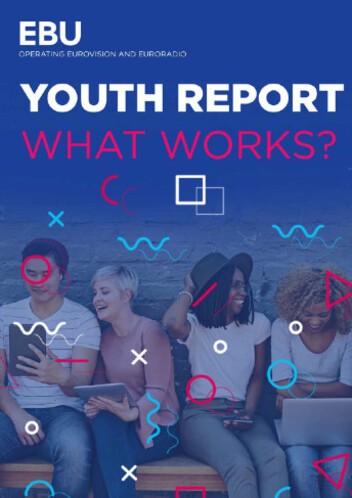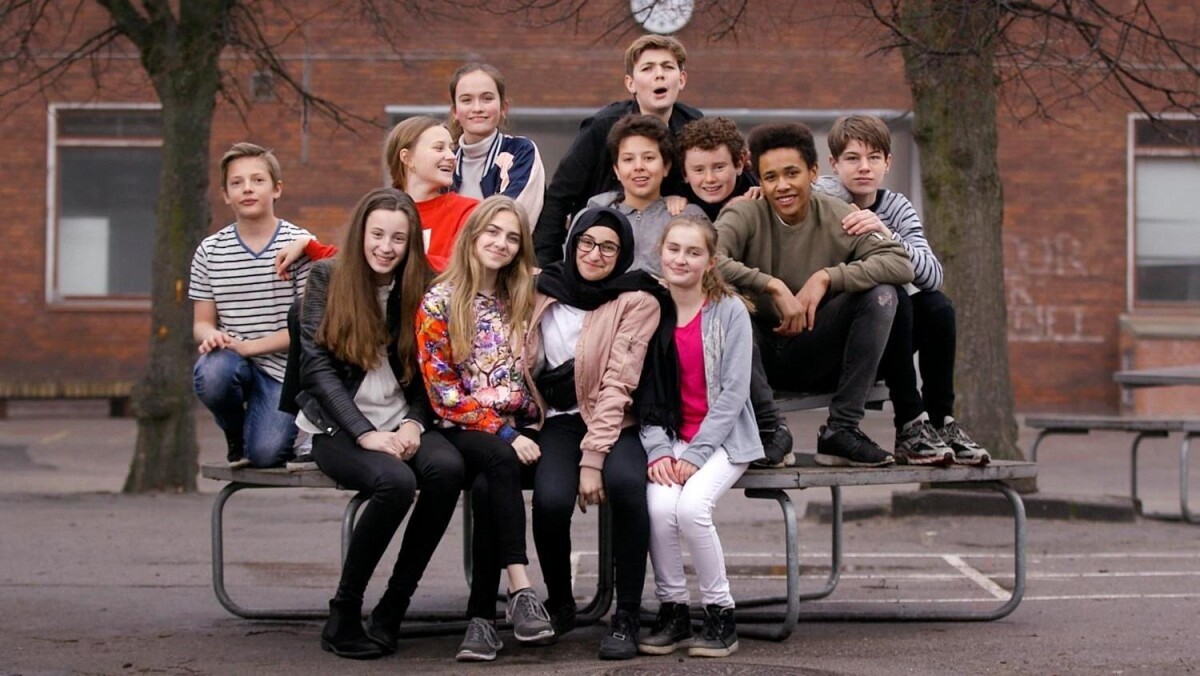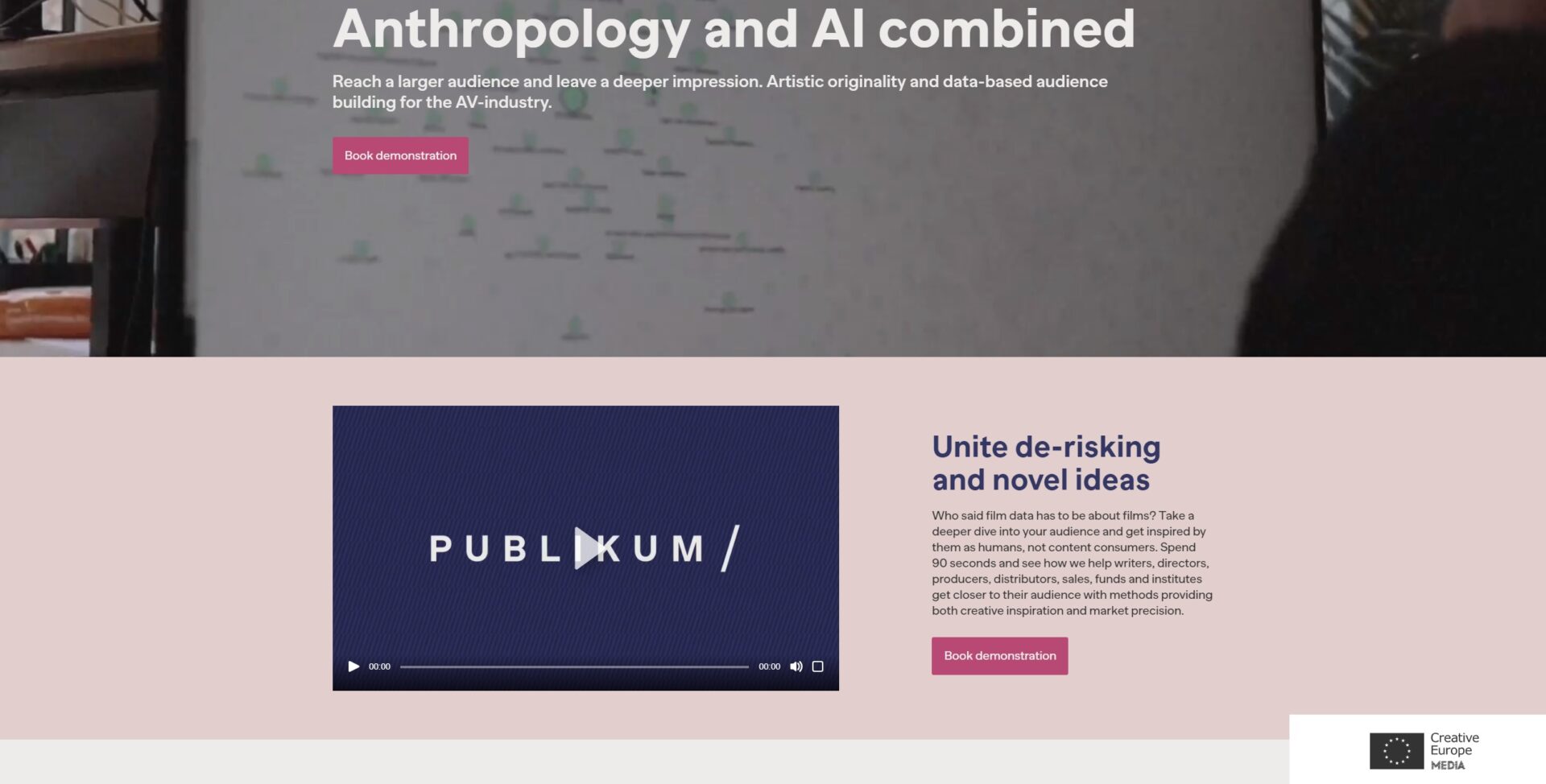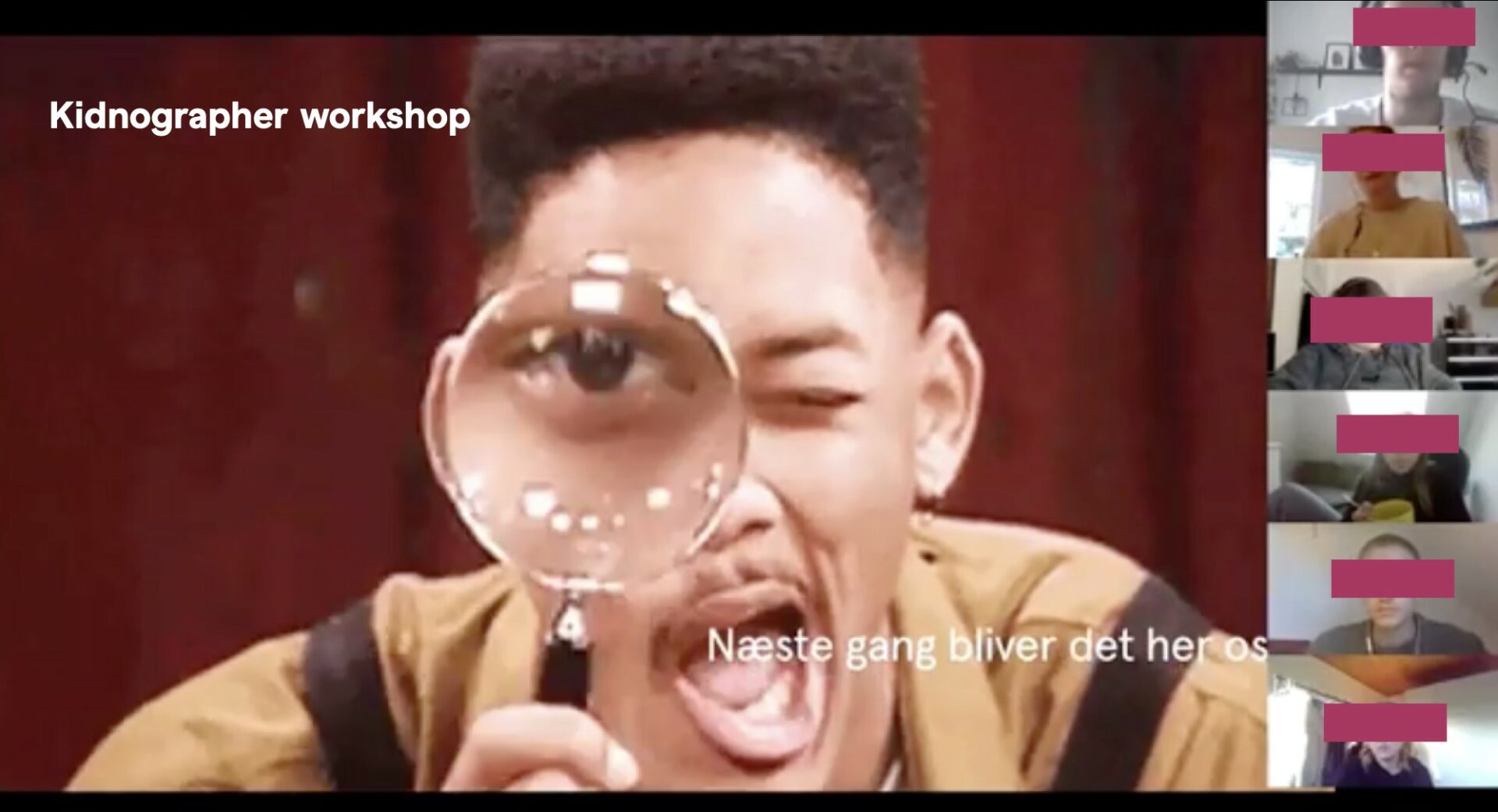As has been noted by several scholars in recent years, retaining and attracting audiences – especially young audiences – has become of particular importance to public service broadcasters (PSB) around the world due to challenges presented by the current age of abundance marked by fierce competition, convergence culture and digitalization (e.g. Lowe & Bardoel 2007; Andersen & Sundet 2019; EBU 2020).
The Danish Broadcasting Corporation (DR) has been working continuously towards solving this issue, dubbed by some as “the youth challenge” (Andersen & Sundet 2019), by finding new strategies for involving and engaging young audiences in their production framework (Redvall & Christensen 2019).

Fig. 1: As mentioned by EBU in their youth report from 2020, connecting with young adults is a challenge for public service media. (Photo Credit: EBU)
However, the recent intensified competition – not least the launch of Disney+ in the Nordics in fall 2020 – has driven DR to further prioritize developing new strategies for reaching young audiences and embedding audience insights even more in all aspects of their practice. As stated in a press release in spring 2021 by Head of children, youth and new developments, Malene Birkebæk, DR’s ambition is to be the most knowledgeable player on the market when it comes to young audiences (Hansen 2021). This ambition is also rooted in DR’s public service obligations to serve all Danes across age groups as well as a self-declared goal to reach 90 % of young audiences under the age of 23 on a weekly basis by 2023 (Hansen 2021; Olsen 2021).
Coupling audience insights with screen production
Bringing content creators and exhibitors closer to their actual audiences has been observed across a variety of institutions in the cultural sector in the past years – from theatres and museums to concert halls – as described in the academic field of ‘audience development’ (e.g. Maitland 2000; Maitland 2019; Hadley 2021). In television studies, an inspiring example of the audience-centric approach to production has been NRK’s use of ethnographic methods during the development of fiction for young audiences (Andersen & Sundet 2019; Sundet 2021). This strategy received widespread attention following the global success of SKAM (2015–2017), some of which was credited to the use of the NABC method during the development of the series as a way of ensuring that the series would meet the intended young audience’s needs and wants (Redvall 2018).

Fig. 2: DR Ultra school drama Klassen (2016-now) employs ‘junior editors’ in the production framework. Photo credit: Lotta Louise Lemche.
A similar audience turn is now being institutionalized throughout DR’s production framework, encouraging content creators to couple their creative processes with audience feedback and insights. The strategies for this endeavor are versatile and include a ‘youth panel’ consisting of 300 young respondents and a ‘youth corps’ of 50 people (Olsen 2021) as well as the continuous use of ‘junior editors’ (Redvall & Christensen 2021b). While these modes of audience engagement are centered on the development of actual content, DR has also launched a more broad and explorative research into the target group’s needs and wants in partnership with the design anthropology consultancy firm Will & Agency, as will be explored in this blog.
Understanding Generation Z through ethnography
Research on the methods employed to reach young audiences is important to further best practice in the industry and bridge the gap between production studies and audience studies. The new ways of integrating anthropological methods in the production framework is of particular interest in this regard – not the least in a Danish context where an ‘ethnographic turn’, similar to that observed in other Scandinavian countries (Andersen & Sundet 2019), can be witnessed in both the film and television industry.
The design anthropology consultancy firm Will & Agency has played a key role in this new development, being instrumental in the Danish Film Institute’s mission to further audience research and insights during the early development stages of film production (Pedersen 2021). Using a mixed methods approach, the consultancy firm employs an AI-supported qualitative semantic analysis of social media data coupled with qualitative mobile ethnography to investigate audiences’ needs and wants related to themes, characters, dialogue and other script-centered aspects of specific film productions in order to inspire the filmmakers’ creative processes through audience insights (e.g. Dam 2020; Pedersen 2021).

Fig. 3: Will & Agency works with audience research in the film and television industries, using anthropological methods to harvest audience insights and inspire engagement. Read more at publikum.io. (Photo Credit: Will & Agency)
However, when doing research for DR, Will & Agency was tasked with making an extensive report of the life-worlds of 10-to-25-year-olds, the so-called Generation Z (born 1995-2010). According to senior consultant at Will & Agency, Rikke Flodin, the brief was not to instrumentalize audience insights to inspire specific creative decisions in the development process, but rather to develop a closer understanding of the demographic’s needs, wants and interests on a more general level that could then inspire content creators’ way of thinking about the different audience groups (Flodin 2022). As noted by Flodin, investigating an entire generation is no easy task, as this demographic is highly diverse. Thus, Will & Agency opted early on to split the group into smaller segments based on their different life-worlds: The 10-12-year-olds as those “signing in” to new communities, 13-14-year-olds as those “signing out”, 15-18-year-olds as the “planners”, 19-22-year-olds as “project managers” and 23-25-year-olds as the “ponders” (Flodin 2022).
Avoiding blind spots with ‘kidnographers’
Through mobile ethnography, conducted over seven consecutive days on a representative population of 34 respondents across age groups, geography, gender and ethnicity, combined with classic home interviews with another 12 respondents, Will & Agency explored how the young generation related to five different prisms: School, community life, media, family and friends. The aim was to test different hypotheses relating to the audience groups’ needs and wants. This qualitative analysis was informed by preliminary desk research on the audience that helped indicate which hypotheses and prisms to explore. One of the keys to getting credible insights was to partner with ‘kidnographers’ – young people who were trained in basic anthropological methods by Will & Agency. These kidnographers would then help identify the most relevant research questions and interpret the findings from a kid’s perspective, inspiring the grownup anthropologists to focus on insights they might otherwise have missed (Flodin 2022).

Fig. 4: As part of their study for DR, Will & Agency worked with ‘kidnographers’. (Photo Credit: Will & Agency)
While the five different segments of the generation had various characteristics, the analysis was able to identify several recurring traits across the ages 10-25. For instance, the analysis concluded that the generation was marked by high hopes and ambitions, a lack of youth rebellions, high self-awareness but low group-awareness and a perfectionist focus on imperfection. This overall data was then supplemented by more specific insights into the attributes of each of the five life-worlds (Flodin 2022). While the main purpose of the insights was to give an overview of the diverse audience group(s), several of the insights have the potential to feed directly into the production framework. For instance, the analysis highlighted that young audiences are allergic to content that has an educational purpose. The insights on high self-awareness and low group-awareness also specified a need to watch other people interact; one respondent stated that although she was in a relationship, she was eager to see how other people’s relationships worked to estimate if she was ‘doing it the right way’.
PSB dilemma: Staying national, but avoiding cringe
Another, more troubling, insight for PSB with a mandate to create national content was that audiences often found Danish-language content to be “cringe”. Some respondents noted that they would not watch content in Danish concerning specific topics such as sex, as it would be too awkward, opting instead to watch shows like the English-language Netflix series Sex Education (2019-now) dealing with the same theme. However, according to Flodin this knowledge should not be viewed as a negative, but rather as an opportunity for creatives to address this issue head-on and explore ways to bridge the awkwardness from the get-go, e.g. through ensuring authentic dialogue (Flodin 2022).
The report on young audiences underlines DR’s efforts to gain a deeper understanding of the illusive demographic that is not just rooted in quantitative data concerning viewing habits, but also in qualitative data on their daily lives, needs and wants. As pointed out in a study on DR’s former youth channel DR3, new modes of production can place content creators under a “creative pressure” (Andersen 2019). In turn, studies on how audience data is implemented in their creative process is needed to further the understanding of this “datafied screen production” (Rasmussen 2020). Another aspect of the report that warrants further analysis is its durability in times of ever-changing audience behavior. How often must new audience research be conducted and does the gained insights of the analyses match the time and money spent obtaining them?

Fig. 5: The sex-positive youth series Salsa (2022-now) at DR used audience research during the development process to gain insights on the young audience’s needs and wants related to the topic. Photo credit: Jesper Christensen
Flodin stresses that Will & Agency’s analysis was not intended to present clearcut do’s and don’ts for TV professionals, but DR has since found that such guidelines could be valuable in order for creatives to successfully interpret how audience data can feed into their work processes. Indeed, as more audience data becomes available for film and television professionals it also begs the question as to how this data is analyzed and implemented in an efficient manner (Sundet 2021). As a result, Will & Agency is now conducting a similar study of 3-9-year-olds that will focus more clearly on what specific content, the age group is interested in (Flodin 2022). One of the methods employed for this purpose is to have children draw and explain stories which they would like to see on screen – a type of co-creation that has similarly been employed at DR before, for instance in the show Børns fantastiske fortællinger (Children’s fantastic stories, 2018–2019), where children’s own stories are turned into animated films (Redvall 2021).
The RYA project aims to further explore the opportunities and challenges that this audience turn poses to the production framework for DR and other broadcasters as well as other methods currently used by various stakeholders to further audience engagement. One interesting case to follow considering Will & Agency’s findings on young audiences’ opinion of national content dealing with sex will be the newly released youth series Salsa (2022–now) at DR, as it deals explicitly with the topic of sex and explored ways to address it through audience research during the development phase (Ludvigsen 2022).
For now, reports such as the one presented by Will & Agency illustrate that much work is being undertaken to further audience understanding. Having already used their methods on films and series in Norway, Belgium and Holland, Will & Agency is working towards integrating their methods in other national screen industries with their Creative Europe-backed platform for audience development, Publikum.io. As stated by Flodin, one of Will & Agency’s main goals is to start a new movement where screenwriters, directors and producers no longer perceive engaging with and understanding their intended audiences early on in the development process as a bad creative decision (Flodin 2022). As this method becomes more widespread – similar consultancies operate in other countries such as Kids Know Best in the UK – sharing these audience insights with other stakeholders can be crucial to further best practice and collaborations within the industry. As of now, Will & Agency’s report for DR is sadly unavailable to the public in its entirety, as DR has opted to share only selected insights on seminars and conferences.
Jakob Freudendal is a research assistant in the collaborative project ‘Reaching Young Audiences: Serial Fiction and Cross-Media Story-worlds for Children and Young Audiences’ at the University of Copenhagen.
Acknowledgements: A special thanks to Rikke Flodin and Niels Alberg from Will & Agency for sharing their experiences with researching young audiences.
References
Andersen, Mads Møller Tommerup (2019). DR3 og det kreative pres. PhD Thesis, University of Aarhus, Denmark.
Andersen, Mads Møller Tommerup, Sundet, Vilde Schanke (2019). ”Producing online youth fiction in a Nordic public service context”. In: Bourdon J., Buchman M. C., Kaufman, P. B (eds.), Journal of European Television History and Culture 8(16), pp. 110-125. http://doi.org/10.18146/2213-0969.2019.jethc179
Dam, Freja (2020). “Publikumsresearch fra pigeværelset”. Dfi.dk. Available at: https://www.dfi.dk/branche-og-stoette/viden-om-publikum/publikumsresearch-fra-pigevaerelset (Accessed 2 July 2022).
EBU (2020). “Youth report – What works?”. Ebu.ch. Available at: https://www.ebu.ch/resources/youth-report (Accessed 14 July 2022)
Flodin, Rikke (2022). Research interview by Jakob Freudendal in Copenhagen, 31 May 2022.
Hadley, Steven (2021). Audience Development and Cultural Policy. London: Palgrave Macmillan.
Hansen, Sarah Cecilie Simone (2021). “DR rykker tættere på de danske unge”. Dr.dk. Available at: https://www.dr.dk/om-dr/nyheder/dr-rykker-taettere-paa-de-danske-unge (Accessed 2 July 2022).
Maitland, Heather (2000). A Guide to Audience Development. London: Arts Council of England.
Maitland, Heather (2019). “Who is Developing Who?” In: Nils Wiklander, Johanna Hagerius, Anneli Abrahamsson, Dag Rosenqvist, Malin Enberg (eds.), Audience: An Anthology on Art, Culture and Development. Vänersborg: Kultur i Väst.
Lowe, Gregory Ferrell and Bardoel Jo (2007). From Public Service Broadcasting to Public Service Media. Nordicom.
Ludvigsen, Jacob (2022). ”Jonas Risvig om sin seksuelt nybrydende DR-serie: »Vi prøver at vise, hvor intimt vi kan gøre det uden at vise hud«”. Soundvenue. Available at: https://soundvenue.com/film/2022/06/jonas-risvig-om-sin-seksuelt-nybrydende-dr-serie-vi-proever-at-vise-hvor-intimt-vi-kan-goere-det-uden-at-vise-hud-482751 (Accessed 7 July 2022)
Olsen, Emil Rømer (2021). “Nyt studie og ungdomspanel skal gøre DR skarpe på indhold til de unge”. Media Watch. Available at: https://mediawatch.dk/Medienyt/TV/article12912664.ece (Accessed 2 July 2022).
Pedersen, Sanne Juncker (2021). “Mød dit publikum, før der er en film”. Dfi.dk. Available at: https://www.dfi.dk/branchen/viden-om-publikum/moed-dit-publikum-foer-der-er-en-film (Accessed 2 July 2022).
Rasmussen, Nina Vindum (2020). “Data, camera, action: How Algorithms are shaking up European screen production”. AoIR Selected Papers of Internet Research, 2020. https://doi.org/10.5210/spir.v2020i0.11311
Redvall, Eva Novrup (2018). “Reaching Young Audiences Through Research: Using the NABC method to create the Norwegian web teenage drama SKAM”. In: Thornley Davinia (ed.), True Event Adaptation: Scripting real lives. Basingstoke: Palgrave Macmillan, pp. 143–161.
Redvall, Eva Novrup (2021). “Who can say ‘poo’?! The Children’s Media Conference in Copenhagen pointed to major differences in how to think of children’s television in Denmark and the UK”. Cstonline. Available at: https://cstonline.net/who-can-say-poo-the-childrens-media-conference-in-copenhagen-pointed-to-major-differences-in-how-to-think-of-childrens-television-in-denmark-and-the-uk/ (accessed 2 July 2022).
Redvall, Eva Novrup and Christensen, Katrine Bouschinger (2021a). “Co-creating content with children to avoid ‘Uncle Swag’: Strategies for producing public service television drama for tweens and teens at the Danish Children’s channel DR Ultra”. Critical Studies in Television 16(2), pp. 163-180. https://doi.org/10.1177/17496020211005999 & preprint.
Redvall, Eva Novrup and Christensen, Katrine Bouschinger (2021b). “Editorial: Screenwriting for children and young audiences”. In: Journal of Screenwriting 12(3), pp. 259-268. https://doi.org/10.1386/josc_00066_2
Sundet, Vilde Schanke (2021). Television Drama in the Age of Streaming: Transnational Strategies and Digital Production Cultures at the NRK. Cham: Palgrave Macmillan/Springer.





